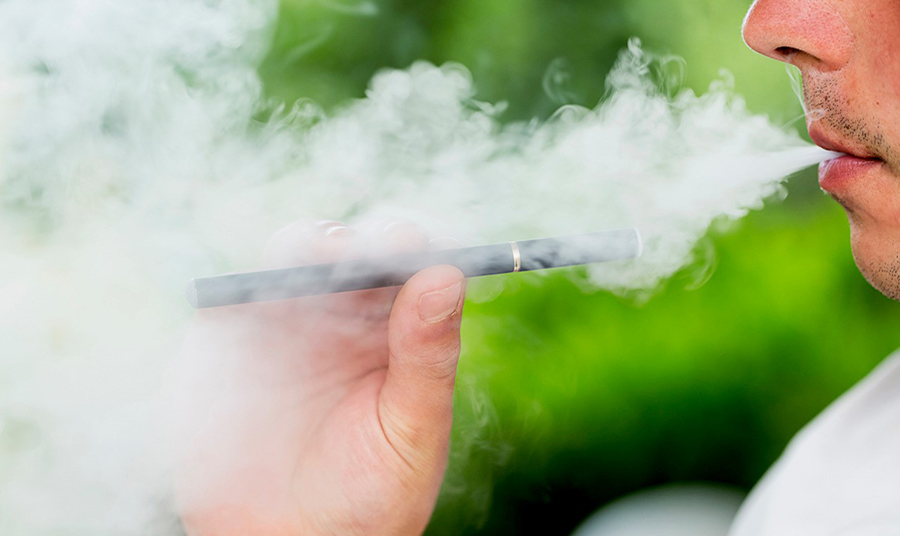Don’t know what “juuling” is? There’s a good chance the teenagers in your life do! Almost 20 percent of middle and high school students have seen other students juuling in school – sometimes in the restroom – sometimes right in the classroom.
This new threat to adolescent health and safety takes its name from the Juul, an attractively designed, sleek e-cigarette device that looks like a USB flash drive. The Juul is easy to hide, easy to use, creates no noxious-smelling odors, and charges in a USB port.
Marketed as an alternative to combustible tobacco, Juul delivers a strong hit of nicotine wrapped in vapors of fruit, mint and food such as vanilla cake. Pods are cheaper to buy than a pack of cigarettes while delivering an equal amount of nicotine.
How popular are e-cigarettes among teens? For the fifth year running, they were reported to be the most commonly used tobacco product in the U.S. by middle and high school students, according to the 2018 National Youth Tobacco Survey. The survey found that from 2017 to 2018, youth use of e-cigarettes increased 78 percent among high school students, and 48 percent among middle school students. Currently one in four teens use e-cigarettes.
This growth has attracted the attention of pediatricians, medical researchers, addiction specialists and the Food and Drug Administration (FDA). “We see clear signs that youth use of electronic cigarettes has reached an epidemic proportion,” FDA Commissioner Scott Gottlieb, MD, said last fall in announcing new steps to address the challenge. “We cannot allow a whole new generation to become addicted to nicotine,” he noted.
While the FDA and other regulators sort things out, the vaping industry continues to grow and push its product as a “safer” alternative for smokers. Currently, advertising for e-cigarettes is not regulated in the same way as cigarette advertising. Thus, kids and teens are exposed to TV, print, radio and point-of-sale advertising extolling the virtues of juuling, vaping and e-cigarettes over combustible tobacco.
“The message teens get from this is that vaping is safe,” said Shawn Freeman, Director of Prevention at New Vista.org, a community mental health center serving 17 counties in central Kentucky.
Getting kids to recognize that juuling is addictive, unhealthy and unwise is a challenge. The younger some starts using nicotine, the more likely they are to become addicted. This increases the changes o becoming a lifelong smoker. Teen tobacco use increase the risk of using other drugs.
A 2018 Stanford University Medical School study found youths using Juul believe themselves to be in control of their nicotine habit. “We ask, ‘Do you feel addicted? And they say no,” reported Karma McKelvey, PhD, the study’s lead author. But when assessed on a scale for loss of autonomy over nicotine, the teens are clearly dependent, McKelvey said.
Further, a 2016 study conducted by the University of Michigan found a majority of young people using e-cigarettes thought they were only consuming flavoring when vaping, not nicotine. Juuls and e-cigarettes cannot be legally sold to minors, but teens buy devices easily online. In addition, Juuls and e-cigarettes are use to inhale other drugs like marijuana and synthetic drugs.
But nicotine is the whole point. Juul markets its products as 5 percent nicotine strength, two to three times that of other vaping products. And it says its unique formulation delivers nicotine to the blood up to 2.7 times faster.
Because our brains don’t fully mature until at least 25 years of age, it’s easy for teens to misperceive risk, Shawn Freeman said. “They may look grown up on the outside, but the prefrontal cortex and limbic systems are still developing, and these portions of the brain are central to critical thinking, risk assessment and decision making.”
While the brain is still developing, teens are subject to impulsivity, risk-taking and experimentation. They are highly vulnerable to social pressure, sophisticated marketing tactics, and subtle messaging. Substance use, including nicotine, can interfere with further brain development, impacting the individual’s ability to focus, learn and remember not only as teens but for the rest of their lives.
Organizations like Truth Initiative are working to increase messaging around the risks of vaping and the FDA is stepping up enforcement efforts. But right now, the onus falls heavily on parents, grandparents, teachers and other adults in teens’ lives. “We have to be informed, to find out what’s going on and teach kids that there is no safe level of nicotine use,” Shawn Freeman said.
For more than 50 years, New Vista.org has provided prevention and early intervention for youth and adults for alcohol, tobacco and other drug use. New Vista Prevention services are geared to prevent or reduce high-risk behaviors such as underage alcohol and tobacco use, prescription drug misuse and abuse and illicit drug use. For more information call the New Vista 24-Hour Helpline at 1.800.928.8000 or call Prevention at 859.225.3296. We’re here to help.

